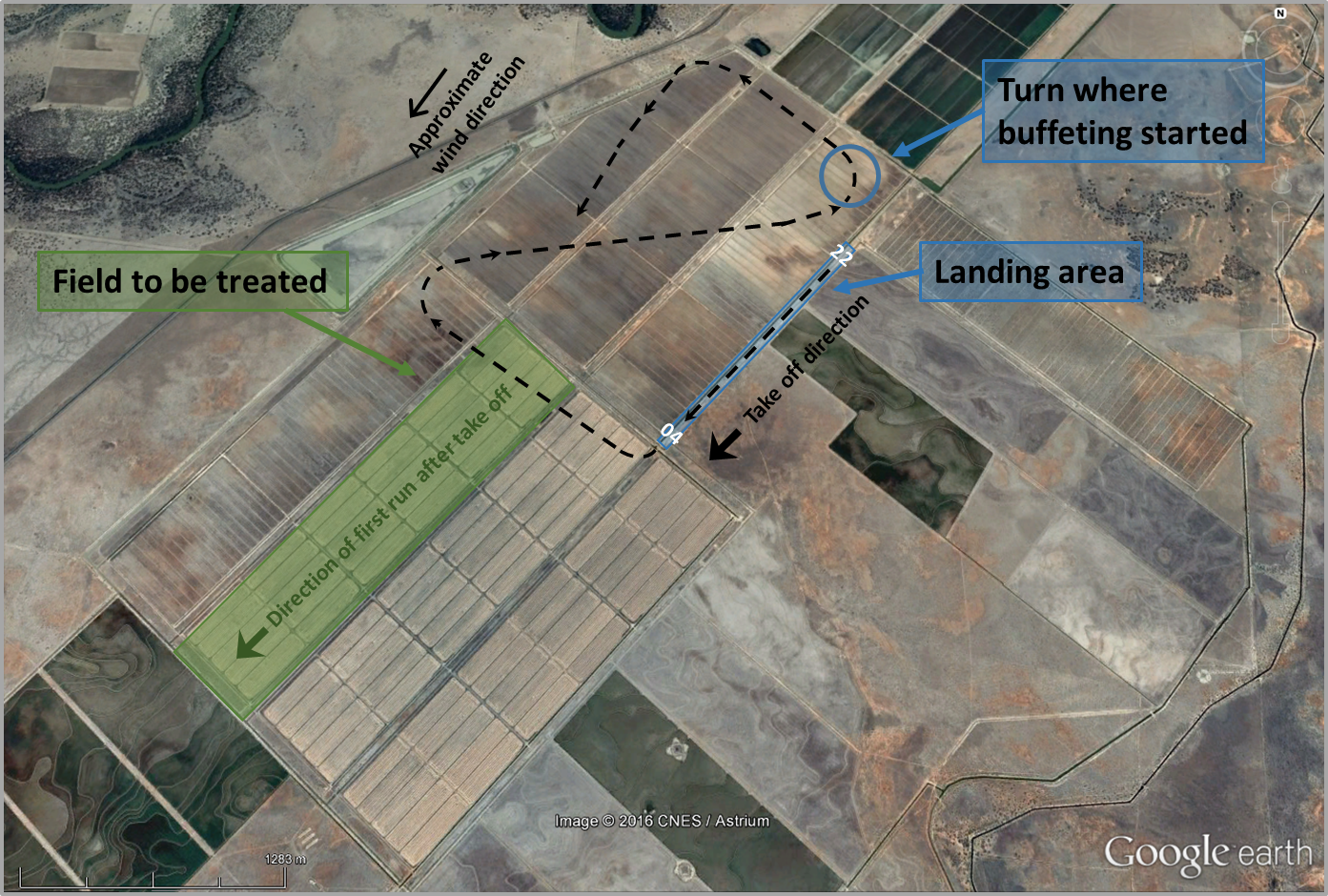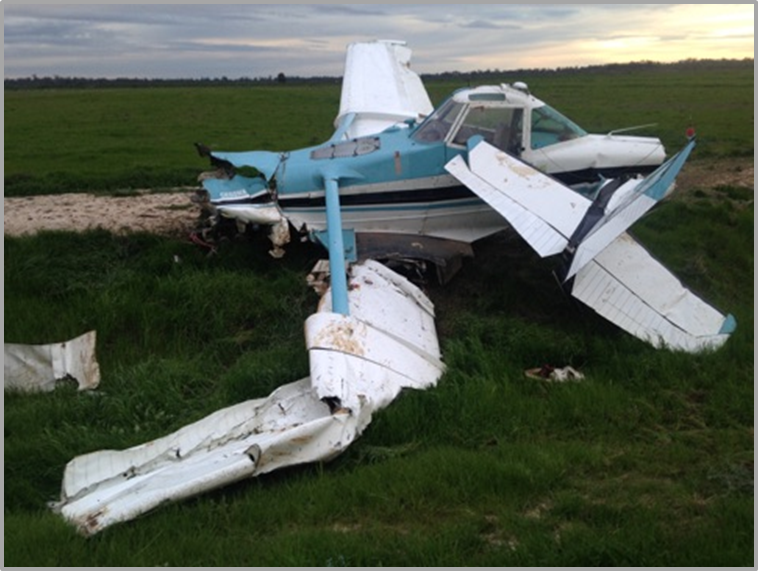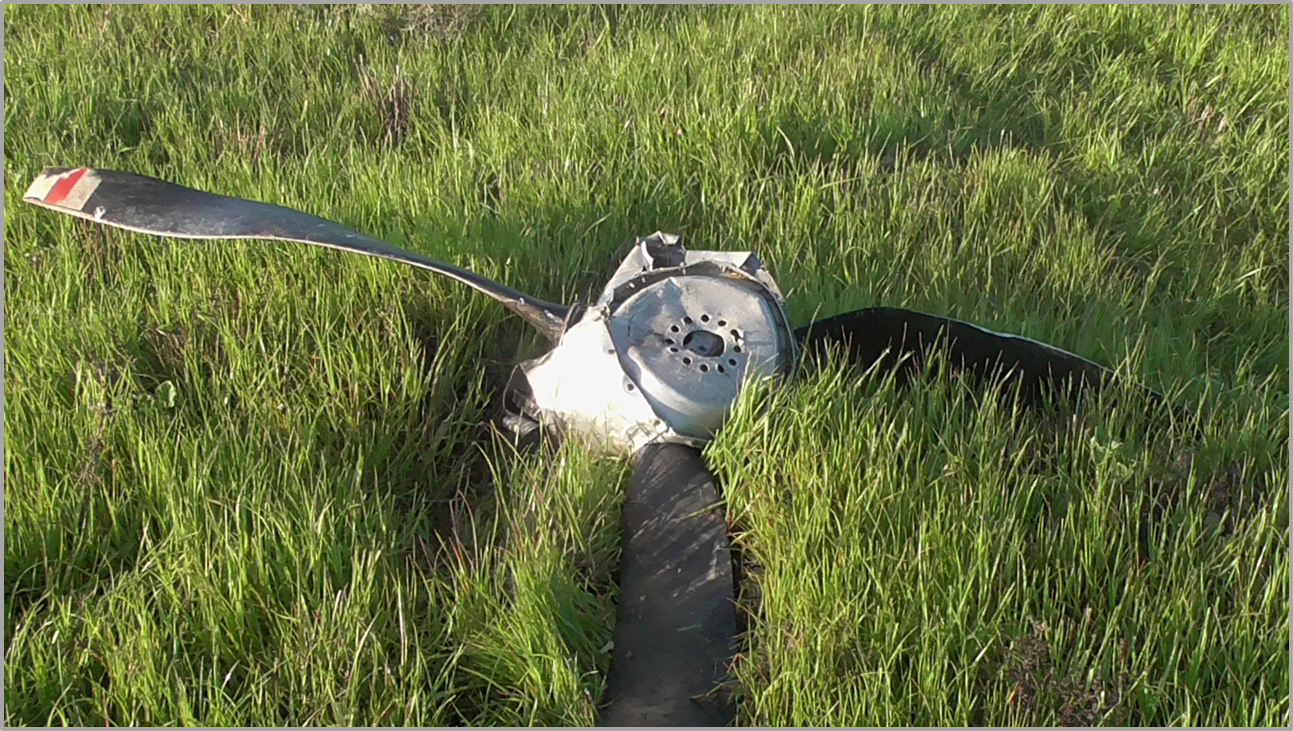On 9 August 2016, at about 1310 Eastern Standard Time, a Cessna A188B aircraft, registered VH-BCT, taxied to depart from a private strip near Hay Airport, New South Wales to complete a run to spread fertiliser on the property. The pilot was the only person on board the aerial agriculture operation.
During the take-off, the pilot noticed a vehicle traveling along a road at the beginning of the spreading run for that field. The pilot climbed the aircraft to about 200 ft and commenced an orbit to allow the vehicle to move out of the way.
During the 30-degree turn to the left, the aircraft started an aerodynamic buffet. The pilot moved the engine controls to full power but did not notice a difference in engine noise or a change in the aircraft performance. The pilot levelled the aircraft wings, lowered the nose to increase speed and with no change in the performance, began jettisoning the load. The pilot elected to return to the airstrip to check the operation of the engine and commenced a gentle turn to the left. The aircraft continued to buffet and the altitude continued to decrease, despite having full engine power selected and the load being jettisoned. When it became evident that the aircraft was not going to make the strip, the pilot elected to land straight ahead. The aircraft collided with the ground on the flat area between two channels. The landing gear and propeller detached and the aircraft came to rest on the top of a channel. The pilot was uninjured and the aircraft was substantially damaged.
The accident highlights the importance of taking positive action and maintaining aircraft control in both turning back to the strip or conducting a forced landing, while being aware of flare energy and aircraft stall speeds.
What happened
On 9 August 2016, at about 1310 Eastern Standard Time (EST), a Cessna A188B aircraft, registered VH-BCT (BCT), taxied to depart from a private strip near Hay Airport, New South Wales to complete a run to spread fertiliser on the property. The pilot was the only person on board the aerial agriculture operation.
The pilot had already completed two spreading runs, for the field being treated, and on each occasion, the pilot took-off and banked the aircraft to the right, and then banked to the left to align with the field. During the third take-off, the pilot noticed a vehicle traveling along a road at the beginning of the spreading run for that field. The pilot climbed the aircraft to about 200 ft and commenced an orbit to allow the vehicle to move out of the way (Figure 1).
Figure 1: Map showing the location of the landing area, field to be treated and the aircraft flight path

Source: Google earth, modified by the ATSB
During the 30-degree turn to the left, the aircraft started an aerodynamic buffet.[1] The pilot moved the engine controls to full power but did not notice a difference in engine noise or a change in the aircraft performance. At the same time, the pilot levelled the aircraft wings, lowered the nose to increase speed and as there was no change in the performance, they began jettisoning the load. Due to the load type, the pilot had to jettison the load slowly so as not to block the spreader. The pilot elected to return to the airstrip to check the operation of the engine and commenced a gentle turn to the left. The aircraft continued to buffet and the altitude continued to decrease, despite having full engine power selected and the load being jettisoned. The pilot continued to lower the nose of the aircraft and when it became evident that the aircraft was not going to make the strip, the pilot elected to land straight ahead. As the aircraft flew over a channel, the tail wheel clipped that channel, and the aircraft collided with the ground on the flat area between two channels. The landing gear and propeller detached as the aircraft continued forward and came to rest on the top of the opposite channel. As there was a lot of fuel leaking from the fuel tanks, the pilot quickly turned off the engine magnetos and the electrical master switch and exited the aircraft through the cockpit door. The pilot was uninjured, and the aircraft was substantially damaged (Figure 2).
Figure 2: BCT at the accident site

Source: Aircraft owner
Pilot comment
The pilot indicated that the wind was steady throughout the day, 12 to 15 knots gusting to 20 and from a northerly direction.
The pilot commented that the engine was not performing how it had been on the previous 17 flights that day. They also reported that at about 200 ft, there was little time from when the problem was first noticed to when the aircraft landed. The pilot reported expecting an instant response when full power was applied, a change in engine noise, and the aircraft should have gained airspeed and continued flying like had happened on previous turns.
The pilot indicated that the aerodynamic buffet occurs frequently during the spreading of fertiliser and occurs well above an aerodynamic stall. It indicates that the aircraft is getting slow and to ease off the pressure on the control column and increase engine power. The pilot reported that the aircraft maintained an aerodynamic buffet all the way to the ground.
The pilot indicated that the aircraft’s seat restraint was a 4-point harness and that they had locked the inertia reel system for the flight and it had worked well. The pilot was wearing a helmet at the time of the accident.
The aircraft was refuelled the night before the accident at Hay Airport and again from fuel drums about 20 minutes flight time prior to the accident. The pilot completed fuel drains on the aircraft and the drum pump and did not notice any issues. The pilot checked the fuel from the drums after the accident and found no contamination. Another aircraft completed the spreading job the day of the accident and also used the fuel from the drums and had no issues.
Operator comment
The aircraft operator conducted an investigation and identified the following:
The pilot had completed 17 similar flights that day, prior to the accident flight.
During the turn, the pilot allowed the aircraft speed to diminish and they did not have the height to recover.
The aircraft was loaded with about 600 kg fertiliser and about 130 litres of fuel. The aircraft engine and propeller had been modified from a Continental IO-520 engine to a Continental IO‑550 engine with a three bladed constant speed propeller.
A licensed aircraft maintenance engineer inspected the engine and no reason was identified for an engine power loss. The engine magnetos and engine carburettor were tested separately and found to be operating normally. As such, the operator believed the engine was still producing full power at the time of the accident. The engine and propeller were extensively damaged by the accident sequence (Figure 3).
Figure 3: BCT damaged propeller[2]

Source: Aircraft owner
The pilot had about 1,927 flight hours in the Cessna 188 conducting top dressing operations. In the last 12 months, the pilot had predominately flown an Air Tractor AT-502 turbo propeller aircraft and more recently had flown about 40 flight hours in the Cessna 188. Unlike the AT-502, there is very little difference between working power and full power in the Cessna 188. This may have resulted in the pilot having an over expectation of the aircraft performance especially when fitted with a spreader.
The aircraft was also fitted with vortex generators[3] that allowed the aircraft to have a lower stall speed than the published stall speed. However, when the stall is reached there is considerable more speed required to resume normal flight and also more height loss to regain that speed at the working height of 150 to 250 ft. With the aircraft fully loaded, the pilot would not have enough height to regain enough speed to recover.
Another company pilot was also flying about 74 km south of the accident site, in a different aircraft type. They experienced down drafts, 20 knot winds, and a downgrade of performance in the downwind turns. With the increase of engine power, the effect of a downwind turn was negated.
Safety analysis
During a turn, the pilot allowed the speed to decrease and the aircraft started a buffet like an approaching aerodynamic stall. The pilot lowered the nose of the aircraft to increase the speed, levelled the wings, selected full engine power and started jettisoning the load. The pilot continued to lower the nose of the aircraft in in an attempted to regain control of the aircraft until it collided with the ground. With the vortex generators, the full load, and the minimal difference between working and full engine power, there was not enough height to recover the aircraft.
Although the pilot believed the aircraft engine was not performing as well as it had in previous flights there was no indications of this before the turn. No problems were identified with the engine after the accident, however, it had been extensively damaged during the accident sequence. The engine’s inability to counteract the effect of the buffeting during the turn (as the aircraft was fully loaded and minimal additional power was available above normal operating power), possibly also influenced by the pilot’s recent experience with a more powerful aircraft, may have influenced this belief.
Findings
These findings should not be read as apportioning blame or liability to any particular organisation or individual.
- During a turn, at a slow speed the aircraft started to buffet like approaching an aerodynamic stall. Due to the vortex generators, full load and insufficient engine power available, there was not enough height for the pilot to regain control of the aircraft before it collided with the ground.
Safety action
Whether or not the ATSB identifies safety issues in the course of an investigation, relevant organisations may proactively initiate safety action in order to reduce their safety risk. The ATSB has been advised of the following proactive safety action in response to this occurrence.
Aircraft operator
As a result of this occurrence, the aircraft operator has advised the ATSB that they are taking the following safety actions:
The pilot has undergone refresher training on the effects of the wind on a downwind turn and flight training in windy conditions with reference to the airspeed and lighter aircraft weights.
Safety message
In this accident, the time available to manage the degradation of the aircraft performance meant that there were little options in regards to a landing area. The accident highlights the importance of taking positive action and maintaining aircraft control in both turning back to the strip or conducting a forced landing, while being aware of flare energy and aircraft stall speeds.
__________
- Aerodynamic stall occurs when airflow separates from the wing’s upper surface and becomes turbulent and results in reduced lift. The stall is preceded by a mild, aerodynamic buffet, which increases in intensity as the stall is approached.
- The damage to a propeller alone cannot accurately quantify the power produced by an engine. There are many inconsistencies in the way propellers bend and twist under impact loads. Some variables include terrain type and surface, angle and speed of the aircraft at impact (Manual of aircraft accident and incident investigation Part III — Investigation ICAO Doc 9756-AN/965, is available from the US Naval Safety Centre website).
- Vortex generators re-energise the airflow over an aerofoil. They are usually placed where the airflow starts to lose laminar flow and becomes turbulent. The result is that airflow sticks to the wing better, permitting flight at lower airspeeds with improved control authority if installed and maintained correctly Civil Aviation Safety Authority (CASA) AWB 02-056 Issue 1 - Vortex Generators and Aerodynamic Configuration Control for Small Single and Twin Engined Aircraft, is available from the CASA website.
Purpose of safety investigationsThe objective of a safety investigation is to enhance transport safety. This is done through:
It is not a function of the ATSB to apportion blame or provide a means for determining liability. At the same time, an investigation report must include factual material of sufficient weight to support the analysis and findings. At all times the ATSB endeavours to balance the use of material that could imply adverse comment with the need to properly explain what happened, and why, in a fair and unbiased manner. The ATSB does not investigate for the purpose of taking administrative, regulatory or criminal action. TerminologyAn explanation of terminology used in ATSB investigation reports is available here. This includes terms such as occurrence, contributing factor, other factor that increased risk, and safety issue. Publishing informationReleased in accordance with section 25 of the Transport Safety Investigation Act 2003 Published by: Australian Transport Safety Bureau © Commonwealth of Australia 2017
Ownership of intellectual property rights in this publication Unless otherwise noted, copyright (and any other intellectual property rights, if any) in this report publication is owned by the Commonwealth of Australia. Creative Commons licence With the exception of the Coat of Arms, ATSB logo, and photos and graphics in which a third party holds copyright, this publication is licensed under a Creative Commons Attribution 3.0 Australia licence. Creative Commons Attribution 3.0 Australia Licence is a standard form licence agreement that allows you to copy, distribute, transmit and adapt this publication provided that you attribute the work. The ATSB’s preference is that you attribute this publication (and any material sourced from it) using the following wording: Source: Australian Transport Safety Bureau Copyright in material obtained from other agencies, private individuals or organisations, belongs to those agencies, individuals or organisations. Where you wish to use their material, you will need to contact them directly. |


